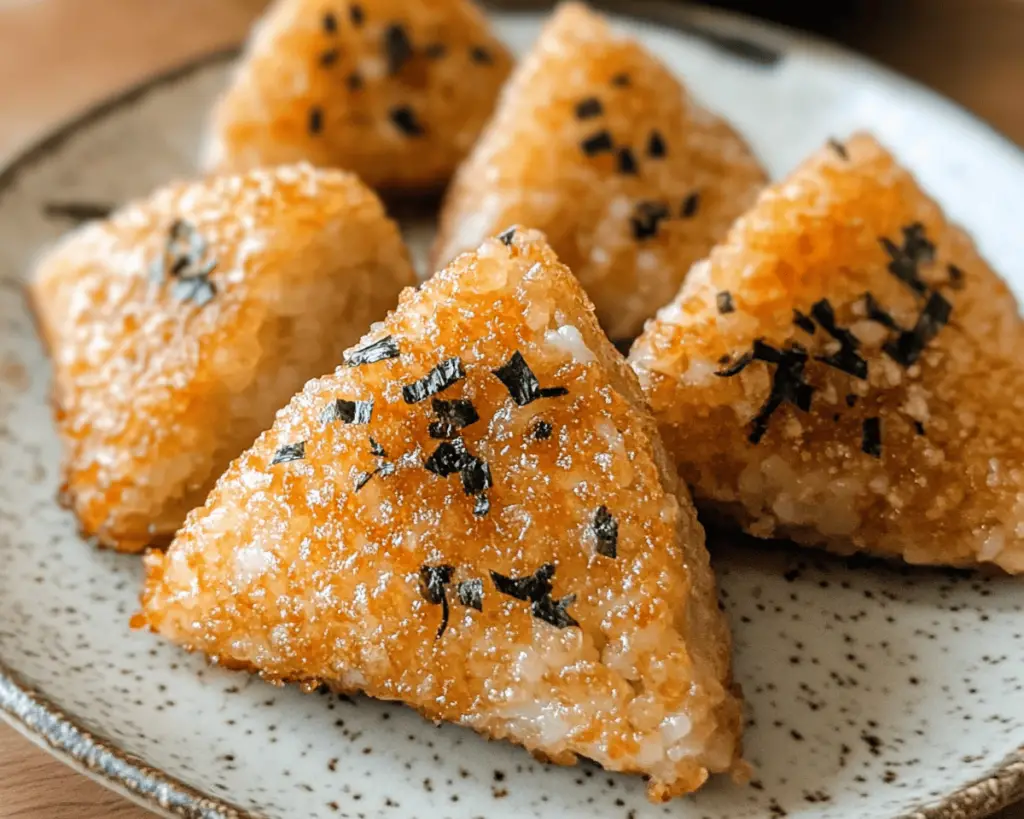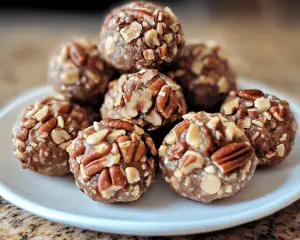I still remember the first time I had a crispy yaki onigiri. It was a rainy day in Tokyo, and I was wandering through the narrow streets of the Shinjuku district after a long day of exploring. Seeking shelter from the downpour, I ducked into a small, unassuming shop. The warm, savory aroma wafting through the door was irresistible, beckoning me in like an old friend.
As I entered, I was met with a cozy setting filled with locals, each hunched over bowls and plates, typically enjoying their meals in silence, punctuated only by soft laughter and the occasional clink of chopsticks against ceramic. The chef, a kind-looking woman with flour-dusted hands and a warm smile, caught my eye and leaned over to ask what I would like.
“Yaki onigiri, please,” I replied, somewhat shyly.
She nodded and got to work, and I watched in awe as she shaped the rice into perfect triangles, brushing them with a glossy mixture of soy sauce and mirin before placing them on the grill. A gentle sizzle filled the air, mingling with the rising steam from the cooking rice, and my stomach grumbled in anticipation. Moments later, she slid the crispy onigiri onto a small plate, their golden, slightly charred edges catching the light, inviting and warm.
That first bite was transcendent: the exterior was crisp and smoky, while the inside remained warm and tender, infused with the umami of the seasoning. It felt like a hug from the inside, and I instantly knew I had stumbled upon a culinary treasure. I savored each bite, realizing at that moment that food could be a vessel for memory—a bridge connecting past and present, solitude and warmth.
In the years that followed, I became obsessed with recreating that yaki onigiri, each batch a gentle homage to the rainy day that changed my understanding of comfort food. The recipe became part of my life, offering warm memories during quiet evenings or family gatherings. Whenever I make crispy yaki onigiri, I stand in my kitchen, looking out at the world outside, and allow myself to be transported back to that humble little shop where it all began.
Inside the Ingredients of Crispy Yaki Onigiri
Let’s take a moment to explore the beautiful components of this dish that brings a taste of Japan to your home. Each ingredient holds a part of the story, contributing to the flavor, texture, and the heart behind the meal.
Short-Grain Rice:
This is the star of the show, the canvas upon which all the flavors are built. Short-grain rice is sticky, allowing it to hold together beautifully when shaped into triangles. The texture is crucial, as you want that satisfying bite. I often use Japanese sushi rice, which has the perfect balance of starch and moisture to create that comforting, chewy center. Remember to rinse the rice under cold water until the water runs clear—this removes excess starch, prevents the onigiri from becoming gummy, and leads to a perfectly tender result.
Soy Sauce:
The golden liquid that transforms the bland into the sublime. For yaki onigiri, I prefer a good quality soy sauce; its umami richness beautifully complements the rice. This is the moment when the magic happens. When brushed onto the rice before grilling, it gives that delightful contrast of crispy exterior and fluffy inside. If you’re gluten-free, don’t fret—there are many excellent tamari options that deliver the same depth of flavor.
Mirin:
A touch of mirin, a sweet rice wine, adds a caramelized depth to the soy sauce. It rounds out the flavor profile with a hint of sweetness, balancing out the salty soy sauce. I like to think of mirin as the joyful little friend that nudges the other flavors into harmony. Always look for hon-mirin at your local Asian grocery store for the best quality, avoiding those that are too sweetened with additives.
Sea Salt:
Sometimes, simplicity carries the most profound flavor. A pinch of sea salt enhances the rice’s natural sweetness and amplifies the other flavors. It’s a small component, but never underestimate the power of salt—it’s like a warm embrace in every bite. I love using flaky sea salt, sprinkling it lightly over the freshly grilled onigiri before serving as it adds a gentle crunch and a pop of flavor.
Filling of Choice (e.g., Umeboshi, Tuna, or Shitake Mushrooms):
The filling is where you can let your creativity shine. While my go-to is classic umeboshi (fermented plum), which offers a tart and salty punch, I’ve experimented with various fillings over the years, from spicy tuna mixed with mayo to sautéed shitake mushrooms and scallions. The filling introduces a delightful surprise when you take that first bite, and it can also reflect your personal tastes and memories. Each variation tells a different story.
Oil for Grilling (e.g., Sesame or Vegetable Oil):
Finally, we have the oil—crucial for achieving that coveted crispy exterior. Sesame oil, with its nutty aroma, adds another layer of flavor, while traditional vegetable oil works wonders too. It’s not just for cooking; it helps in developing that lovely golden color and creates the satisfying crunch when grilled. I daresay that choosing the right oil is akin to picking out the perfect accessory; it can elevate the dish in ways you hadn’t imagined.
How Crispy Yaki Onigiri Fits Into a Balanced Life
As I’ve evolved in my culinary journey, so too has my relationship with food. I’ve learned that the joy of cooking lies not only in preparing meals but also in how they fit into the rhythm of life. Crispy yaki onigiri often occupies that sweet spot for me, ideal for a busy weeknight or a slow rainy afternoon, giving me the perfect balance between nourishment and indulgence.
From a nutritional perspective, you’ll find that yaki onigiri offers a wholesome serving of carbohydrates from the rice, the filling adds protein or healthy fats, and the quick grilling gives a satisfying crunch. Plus, the beauty of this dish is that it can be adapted to fit various diets—a vegan filling, a low-carb option with cauliflower rice, or keeping it gluten-free by selecting your sauces wisely.
But more than that, yaki onigiri has taught me to embrace the joy of cooking without judgment. This dish isn’t just about pristine execution; it’s about the experience of creation. I’ve burnt many a batch, watching in despair as they charred far beyond the delicate crisp I aimed for. But, as I often remind myself, those moments have shaped my connection to the kitchen. Each mishap is just a learning opportunity—or sometimes, a delightful surprise when shared with friends over laughter, creating memories that will last far longer than the golden crust on the rice.
More than once, I’ve made onigiri to cheer up a friend going through a tough time. The process of shaping those triangles becomes a meditative act, a reminder that food is love crafted with eager hands. Alongside the rice and the warmth of the grill, I find healing, a remedy for my worries, as well as theirs. Every grilled onigiri becomes a portal, connecting my heartbeats to the joy of sharing food with others.
What You’ll Need
– Short-Grain Rice: 2 cups
– Soy Sauce: 2 tablespoons
– Mirin: 1 tablespoon
– Sea Salt: to taste
– Filling of Your Choice: ½ cup
– Oil for Grilling: 2 tablespoons
– Water for rinsing and cooking the rice
**Servings**: 4-6 onigiri
Preparing Crispy Yaki Onigiri Step by Step
Here’s where the magic happens. I invite you into the process, where each step bursts with potential.
Start by rinsing the short-grain rice gently under cold water in a fine-mesh sieve until the water runs clear. This may be an unassuming step, but trust me; it’s vital. This is where you shed excess starch, so your arches of onigiri don’t become a gummy mess.
Next, combine the rinsed rice and 3 cups of water in a rice cooker or a pot. If you’re using a traditional pot, cover it and bring to a boil. Once bubbling, reduce to a simmer and let it cook for about 15-20 minutes, or until all the water has been absorbed and the rice is tender. This part always makes my heart flutter, as the scent of warm rice fills the kitchen.
Once the rice is cooked, fluff it with a fork and let it cool slightly. You want it manageable, warm enough to mold but not so hot that it burns your hands. As you’re fluffing, consider the filling. If you’re going the umeboshi route, chop it finely; for tuna, mix it with a little mayo and green onion. For sautéed mushrooms, I recommend caramelizing them beforehand with a touch of soy sauce for extra flavor.
Now, here’s where you get your hands dirty. Lightly moisten your hands to prevent the rice from sticking. Scoop about ⅓ cup of the rice into one hand, create a small well in the center, and place a generous teaspoon of your filling inside. Gently mold the rice around it, forming a triangle. Don’t fret if it’s not perfect—the beauty of handmade food lies in its imperfections.
Once shaped, repeat until you have a small stack of onigiri ready for grilling. Set them aside while you heat a non-stick skillet over medium heat, adding a drizzle of your chosen oil. As the oil warms, brush each side of the onigiri with the mixture of soy sauce and mirin.
When the pan is hot enough that a drop of water sizzles, place your onigiri carefully in the skillet, allowing space between each one. Let them grill for 3-4 minutes on each side, or until they develop a beautiful golden-brown crust. Take a moment to relish the smell—it’s everything. You might get a little crispy rice on the bottom of the pan, but fear not, that’s the flavor we want!
As they grill, sprinkle with sea salt to bring out even more flavor. Upon finishing, lift the onigiri gently onto a serving plate. With every wooden spatula squeak, you’ll feel the warmth radiate through your heart.
Serve them warm, with an extra drizzle of soy sauce, or even sliced avocado and pickled vegetables for an added crunch. Every bite you take feels like a warm hug, an ode to that rainy day in Tokyo—the delightful crunch blending with an interior soft as a whisper.
Lessons from My Kitchen
From burnt edges to the perfect golden crisp, my kitchen has transformed into a lively classroom. I remember the first time I tried to rush the grilling process, hoping to get them done quickly. Instead, I ended up with a charred disaster, and in that moment, I sighed in defeat. I learned that great things take time and care.
Over the years, I’ve experimented with all sorts of fillings. I’ve embraced the beauty of seasonal ingredients, using leftover grilled vegetables in the summer or frozen peas and scallions in the colder months. Once, I made a batch for a picnic with friends, stuffing them with roasted sweet potatoes and miso—each bite brought laughter and nostalgia, making me realize how versatile this humble dish can be.
One of the greatest pieces of advice I ever received was from my grandmother. She said, “Cook with your heart, and the flavors will follow.” It’s a mantra I keep close while making onigiri; I allow myself to feel the joy, the resilience during trials, and the laughter shared around the table.
It’s essential to remember that cooking is an art of love: You can pour memories, aspirations, and dreams into every dish. Even as the world becomes faster-paced, yaki onigiri invites us to slow down, to appreciate connection through food, and to recognize that perfection is found not in flawless execution, but in shared moments—the sticky fingers, the laughter, and the warmth of human connection.
(Closing Thought)
Crispy yaki onigiri has forever changed how I see comfort food. It serves not merely as nourishment but as a reminder to pause and appreciate the little things—a bite of warm, fragrant rice, a moment of stillness, the laughter of friends, and the lessons learned through kitchen mishaps. So, as you embark on making this beloved recipe of mine, I invite you to feel every part of it, to shape your memories around it, and perhaps turn it into something uniquely yours. Each onigiri will carry a page of your story, just as mine does. Happy cooking!



